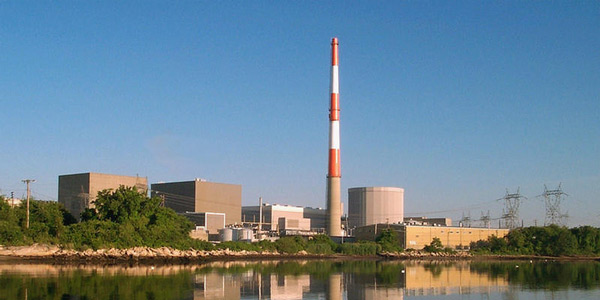By Michael Kuser
Connecticut legislators on Tuesday unveiled a bill that would put the state’s only nuclear power generator, Millstone Station, on equal footing with renewable energy resources.
The bill would allow Dominion Energy’s Millstone to bid into the state procurement process now reserved for renewable energy resources such as large-scale hydropower, solar, wind and trash-to-energy facilities. The bill also would increase the share of Class I renewable energy in the state’s total energy production through 2040 by easy-to-remember increments: 20% by 2020, 29% by 2029 and 40% by 2040. It would mandate an additional 3% each year from Class I or Class II renewable resources, i.e., hydropower or trash-to-energy.

Millstone Nuclear Power Plant | NRC
The General Assembly’s Joint Committee on Energy and Technology is expected to consider the bill, S.B. 106, on Friday along with related legislation, Raised Bill 7247, which aims to establish a carbon price for fossil fuels sold in the state.
The bill supporting Millstone revives a similar measure that passed the Senate at the end of last year’s legislative session, but which the House of Representatives did not have time to consider.
Connecticut lawmakers are riding a trend, as New York approved zero-emission credits for three upstate nuclear plants and Illinois did the same for two plants.
Three other states, New Jersey, Ohio and Pennsylvania, also are considering plans to subsidize their nuclear power generators, which have seen their profits squeezed by low-cost natural gas and renewable generators.
Millstone is New England’s largest power plant and has been owned by Dominion since 2001. The plant has a total generating capacity of 2,111 MW; Unit 2 at 882.5 MW is licensed to operate through 2035, while Unit 3, with 1,228 MW of generating capacity, is licensed to operate through 2040. Millstone produces more than half of the electric power used in Connecticut and about one-seventh of New England’s electric power.
Kevin Hennessy, Dominion’s director of state policy for New England, has been publishing op-ed pieces throughout Connecticut this year to make the company’s case that the proposed legislation cuts out the “middle man” and represents a good deal for state electric power consumers. In an op-ed in the New Canaan News on March 10, Hennessy said that current regulations result in power to consumers being priced high, despite wholesale prices having dropped notably.
“When oil prices drop, we all expect to pay less at the gas pump,” Hennessy said. “Why should electricity be different?”
The early draft of the legislation said its purpose was to provide a mechanism for zero-carbon electric generating facilities to sell power to electric utilities. Sen. Paul Formica (R), committee co-chair and lead sponsor of the bill, said it creates opportunities for the state to get its energy mix right.
“We’re trying to juggle and balance the pieces in the energy puzzle,” Formica told the Hartford Courant. Formica’s district includes Waterford, where Millstone is located.
Not All in Favor
Testifying on March 13 before the Assembly’s Environment Committee, Dan Hendrick, director of external affairs for NRG Energy, said, “One of the most hotly debated issues before the General Assembly this session is Senate Bill 106, which would create a new clean energy [request for proposals] and allow a large, existing nuclear plant to compete against wind and solar for the first time.”
NRG operates 28 generating plants in Connecticut with a combined capacity of 1,900 MW, of which 925 MW is natural gas and liquid fuel-capable. NRG this year joined Calpine, Dynegy and the Electric Power Supply Association in funding “Stop the Millstone Payout,” a campaign to derail the bill.
Hendrick reminded the committee that policies set in Connecticut will affect the other five states in the ISO-NE wholesale market. The RTO is trying to align the electricity markets and state policy proposals through the NEPOOL Integrating Markets and Public Policy (IMAPP) initiative.
“That being said, the three-state threshold of this bill reaches approximately 80% of the electricity load in ISO-NE,” Hendrick said, referring to a provision in the carbon price bill that requires the enactment of similar legislation in Massachusetts and Rhode Island. “Contrast this approach with Senate Bill 106, which would burden only Connecticut ratepayers with the extra costs of an RFP designed to provide unjustified additional revenues to a single nuclear generator.”
Opponents also question the need for state-sponsored financial aid to Dominion and Millstone.
“Nowhere has [Dominion] claimed that Millstone is not profitable, and the company is too cute by half in its arguments as to why it needs special treatment,” said Tom Swan, executive director of the Connecticut Citizens Action Group, in a March 8 letter to the editor of The Middletown Press. “Connecticut ratepayers should not be asked to subsidize a profitable company and we definitely should not weaken our commitment to a renewable energy future by reclassifying nuclear as ‘clean energy.’”


